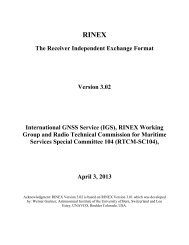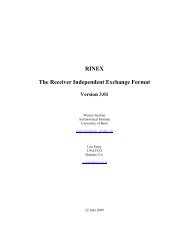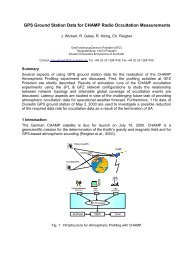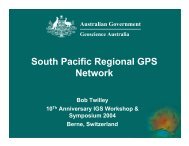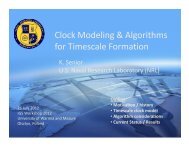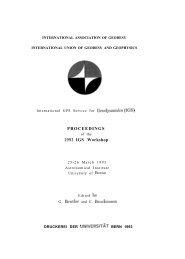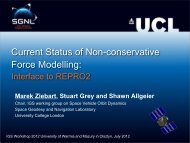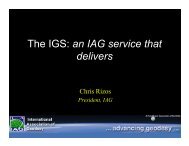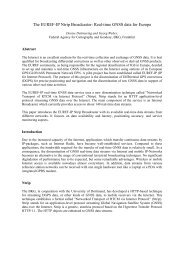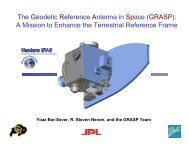IGS Analysis Center Workshop - IGS - NASA
IGS Analysis Center Workshop - IGS - NASA
IGS Analysis Center Workshop - IGS - NASA
You also want an ePaper? Increase the reach of your titles
YUMPU automatically turns print PDFs into web optimized ePapers that Google loves.
to define a reference clock in their local network. An approach that would always work, regardlessof the network location, would be to fix GPS satellite clocks. As pointed out earlier, intentional SAdithering means that the fixed values need to be given frequently enough (at least every 30 seconds)for precise interpolation.Another approach would be to include data from a nearby <strong>IGS</strong> station in the solution, and fix thevalue of its clock to that determined in an <strong>IGS</strong> global solution. Many of the stations have very stableclocks, and the dithering issue that plagues the GPS satellites is not an issue for station clocks.A suggested format for satellite and station clock solutions follows the approach described earlierfor a possible orbit format. Examples of satellite and station clock solutions from such a format isc cod prn16 199309170215 0.0000 6.36451031615e-05 7.03e-08c cod nyal 199309170215 0.0000 3.42833200249e-05 8.63e-08Following fields that identify the record type (“c” for clock), the <strong>Analysis</strong> <strong>Center</strong>, the transmitter/receiver, and the GPS time tag, the clock solution and its uncertainty (both in sec.) follow. Thissimple format has all of the advantages discussed earlier for the proposed simplified orbit format.Furthermore, by judicious choice of time tags, it allows for discontinuities in clock solutions,which occur regularly when station clocks are adjusted to keep their biases small. There is norequirement in such a format that entries for a given transmitter or receiver be equally spaced intime, nor even that solutions for transmitters and receivers be supplied at the same interval.Because of the record identifier field in the above format for clock solutions, and the formatdescribed earlier for orbits, record types could simultaneously exist in a single file, reducing thenumber of files with which to work.(The idea of a record type identifier is not the only way to allow orbit and clocks to coexist in thesame file. For example, orbits could appear first followed by some kind of terminator and then theclock solutions. The record-type-identifier approach has more potential, in that it allows foradditional record types, including, say, ionosphere information, or a “new start” flag for orbits aftera burn.)Ionospheric information.All <strong>Center</strong>s use the ionosphere-free combination of phase and pseudorange, so that the electrondensity of the ionosphere does not need to be modeled. The linear combination L1 - L2 (or, withmore noise, P 1- P2) is proportional to the columnar electron density along the transmitter-receiverline of sight.Although it would be easy to construct an L1 - L2 product as a function of time and transmitterreceiverpair, it is not clear that there would be much of a demand for such a product.More promising would be a model which considered physical causes of spatial and temporalvariations in ionospheric electron density. By using data from the global network, parameters in15




